Shipping and return policies are vital to the bottom line of an ecommerce business.
Many ecommerce stores create their small business shipping and return policies the way people sign their names after a credit card purchase — without much thought (and pretty much just because they have to).
Not only do they impact purchasing decisions on the customer side of things, they also have a ripple effect on your inventory and supply chain management. And the effect of a good (or bad) policy is often overlooked.
That’s why we’re sharing all the details for why all ecommerce businesses need a successful shipping and return policy and how to create one for your store.
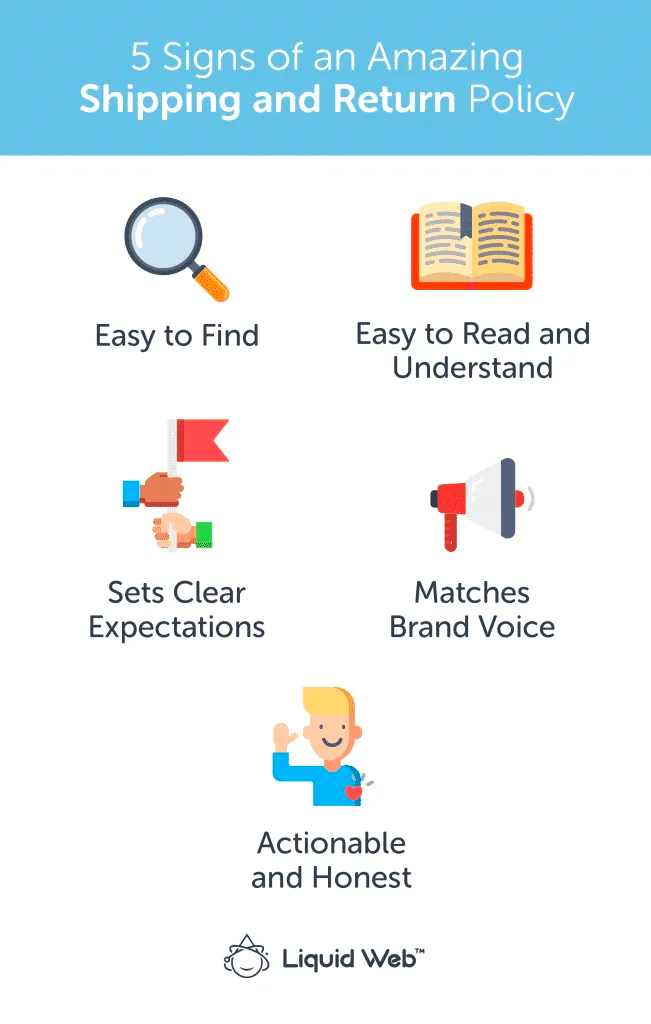
Why You Need a Clear Small Business Shipping Policy
Shipping for small businesses should not be treated as an afterthought. There are three major reasons you need a shipping and return policy that’s clear and easy to find.
1. Your Customers Are Looking for It
You might think that customers don’t want to read this boring section on your website, but the opposite is actually true. Customers shopping online care a lot about shipping and return policies, and they’re likely to seek out yours.
According to the National Retail Federation, as much as 65% of customers actually look up a store’s shipping policy before adding anything to their cart.
2. Bad Shipping Policies Are a Culprit for Cart Abandonment
The dreaded phenomenon of customers leaving a store without following through on buying their cart items happens at a rate of about 75%.
Two of the most common reasons for cart abandonment are related to shipping and returns: Either there’s no clear option for express shipping or the return policy is deemed “unsatisfactory.”
3. A Good Shipping Policy Saves You and Your Customers Time
When a customer can’t find your shipping policy, your policy is hard to understand, or it just doesn’t give enough information, two things can happen: The customer can leave your store, or they can contact your company to get answers.
While the second option is definitely preferable, it means that your team will be spending a lot of time fielding question after question about shipping and returns. That’s time they could be spending on more profit-driven activities.
How to Write a Great Shipping Policy
You could resort to a small business shipping policy generator or download a generic shipping policy template that’ll cover your bases. But, if you’re here, you probably want to write a great policy, which requires more thought and effort.
Here’s what you can do to write a great shipping and return policy.
Prioritize Customer Service When Creating Your Policies
When it comes to creating the “meat” of your policy (i.e., what’s allowed and what’s not), it’s best to think of your customers first and the bottom line second.
You’ve heard that it costs five times as much to obtain a new customer than to keep an existing one, right? One of the best ways to keep customers who are already buying from you is to have as generous a shipping and return policy as you can. Of course, you still want to make sure your policy makes financial sense.
Look for Ways to Do Better Than Your Competition
Just like any aspect of running your business, you should be aware of how your competitors are handling shipping and returns. From there, look for ways that you could improve on what they’re offering.
This doesn’t have to mean offering a more generous shipping and return policy (though it could). It may mean just communicating the policy better, making it easier to find, or going above and beyond with the information provided.
Consider the Questions You Have About Shipping and Returns When Buying Online
You’ve bought things online before — probably plenty of times. So when you sit down to create your shipping and return policy, go back to the moment when you were shopping at an ecommerce store, and remember what doubts and questions you had.
Likely, your customers will have similar questions for your store. At the very least, you probably wondered:
- If you could return the item if you didn’t like it
- When your item would arrive
- If you’d get shipping updates
- Who would be delivering it
Make sure you answer all the questions in your own policy.
Write a Clear Small Business Shipping Policy in Your Brand Voice
If your shipping and return policy sounds like a lawyer wrote it, your customers will, at best, be a little frustrated trying to understand it. At worst, they’ll find it disingenuous or scary.
It’s not a bad idea to have a lawyer review your policy before publishing, just to make sure there aren’t any loopholes. However, it should still read like the rest of your website content, and be written conversationally and in your brand voice.
The 5 Signs of an Amazing Shipping and Return Policy
Do you have a shipping and return policy already? Make sure it meets the following criteria.
1. It’s Easy to Find
Don’t hide your shipping and return policy from customers. Put it where they’ll expect to find it. Usually, that’s in your website footer (like in the example below from The Yoga Warehouse). Bonus points if you include it at checkout or on product pages as well.
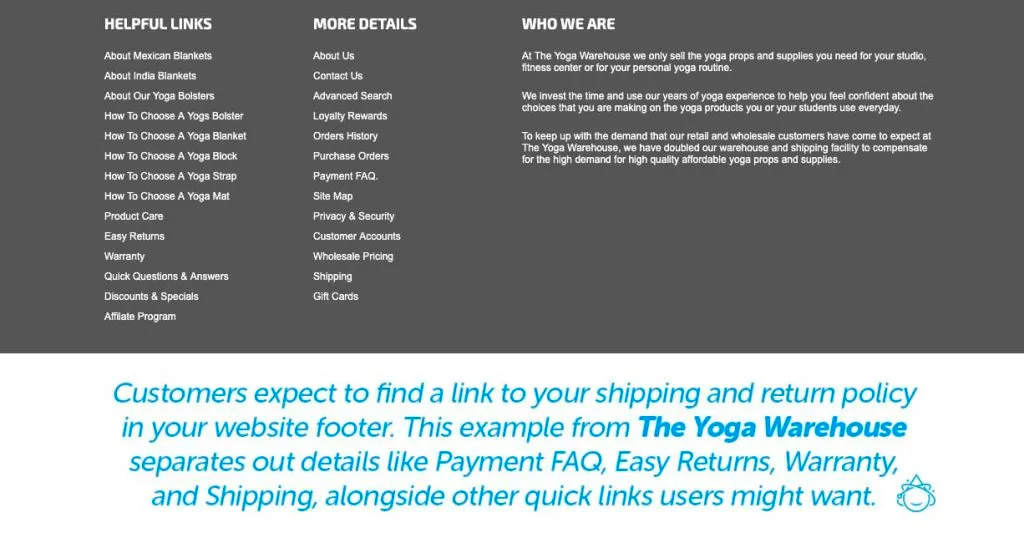
2. It’s Easy to Read and Understand
Keep language simple, sentences short, and the information organized. Great policies are visually designed to be skimmable. That might look like putting the information in a table, using headings and subheadings, or a FAQ format.
3. It Sets Clear Expectations
Because small stores don’t have the credibility of huge brands, shipping for small businesses is extra important to get right. Preemptively answer any questions your customers may have so there are no gray areas.
Common Questions to Answer in Your Shipping Policy
- Where do you ship?
- Do you ship internationally?
- How long does it take for items to arrive?
- How much is shipping?
- Do you offer free shipping?
- Can you combine shipping on more than one item?
- Do you put receipts/invoices in the package?
Common Questions to Answer in Return Policy
- Do items need to be returned in the original packaging?
- Who is responsible for paying the S&H?
- How many days from delivery can items be returned?
- What happens if items arrive damaged?
4. It’s On-Brand
Don’t miss the opportunity to infuse your policies with your brand voice. This is a great way to build more trust with your customers. The policies will feel familiar to customers rather than like scary legalese. Also, customers recognize that you put time into crafting the policies — and believe you care about their experience.
5. It’s Actionable and Honest
Make sure that whatever you write in your shipping and return policy, you’re able to follow through on it every time. Otherwise, word will start to spread that your store is not trustworthy.
Admirable Shipping Policy Examples From Small Ecommerce Businesses
If you’re still stuck finding the right words or format for your shipping and return policy, we’ve shortlisted the four shipping policy examples we love for inspiration.
1. Minted
Here’s what this artist-designed stationery brand does right:
- They introduce their shipping page with a special, on-brand tagline: “Great design delivered right to your doorstep.”
- They provide easy-to-find tabs for “U.S.” and “International” shipping since that information is different.
- They include different shipping costs for different-sized items — with clear labels.
- They spell out how their products are packaged because some items are fragile.
- They explicitly mention that no invoice or pricing is included in the package because it might be a gift.

2. Dearborn Denim & Apparel
This American-made denim company also does a few things right:
- They offer a reminder of the company’s main value proposition that their clothing is crafted by a small team of experts: “Your order ships directly from our sewing floor, not a dropshipper or warehouse.”
- They use humanizing language to address concerns: “Some orders may be delayed due to a temporary shortage of a specific style or size. Rest assured we will be working hard to get those items through production and on their way to you as fast as possible.”
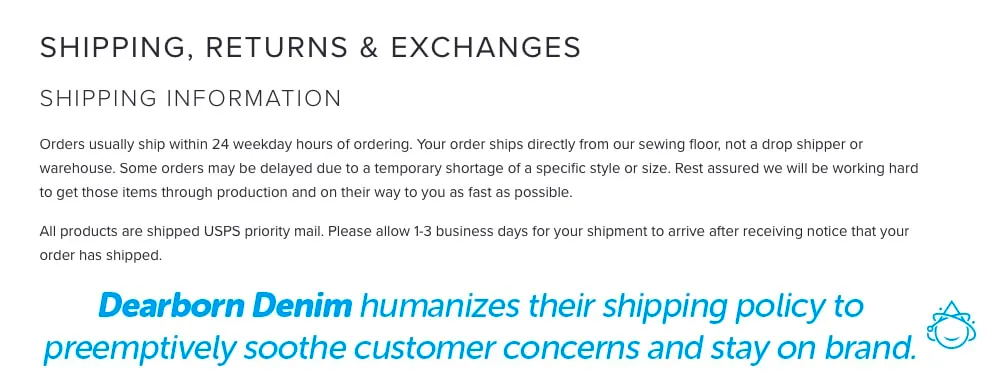
3. Will’s Vegan Store
A vegan shoe and clothing company in the U.K., this store has an excellent shipping policy:
- They arrange their three shipping options in an easy-to-read table.
- They include the dates packages would be expected to arrive, depending on the shipping type (instead of just saying 2 to 3 weeks). This way, the customer doesn’t have to do the math on their own.
- They use an interactive drop-down menu to make it easy to change the ship-to country for accurate details.
- They make sure to highlight their environmentally friendly mission in their shipping policy: “All our shipping & returns are Carbon Neutral and plastic free. We do not use plastic bags or plastic packaging. All the materials in our deliveries are environmentally friendly, sustainable, and can be recycled.”
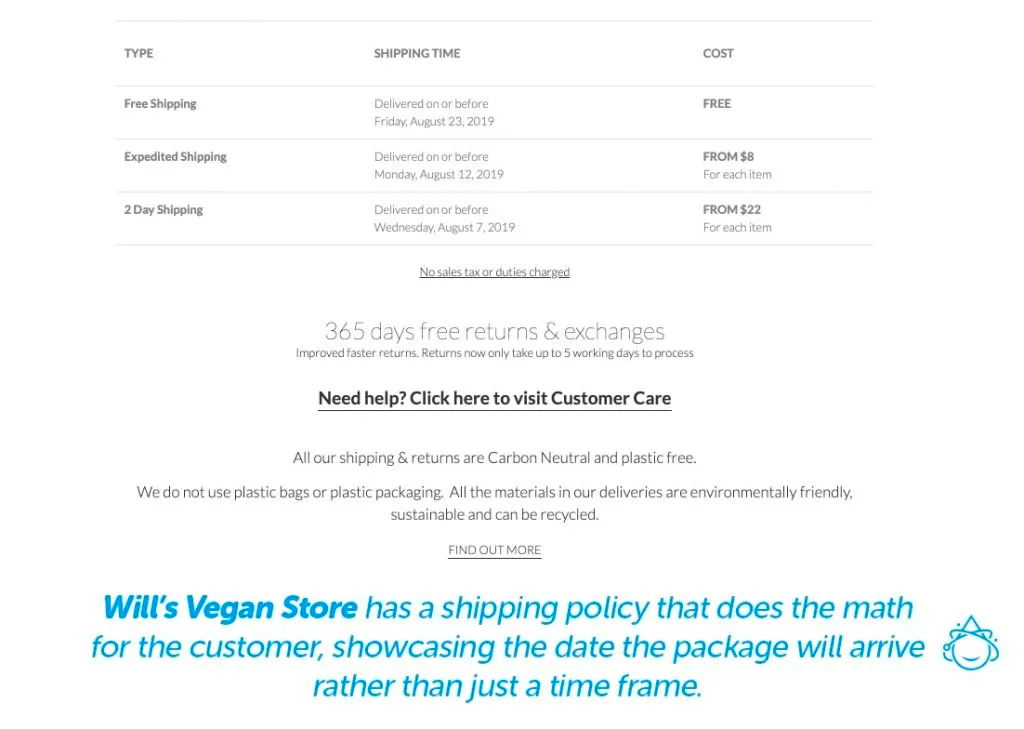
4. Heart Coffee Roasters
This ecommerce coffee bean company does one big thing to make their shipping and return policy customer-focused:
- They organize their entire policy into FAQs with detailed explanations for why their policy is as it is. This means they can share a ton of information without it being daunting for customers.
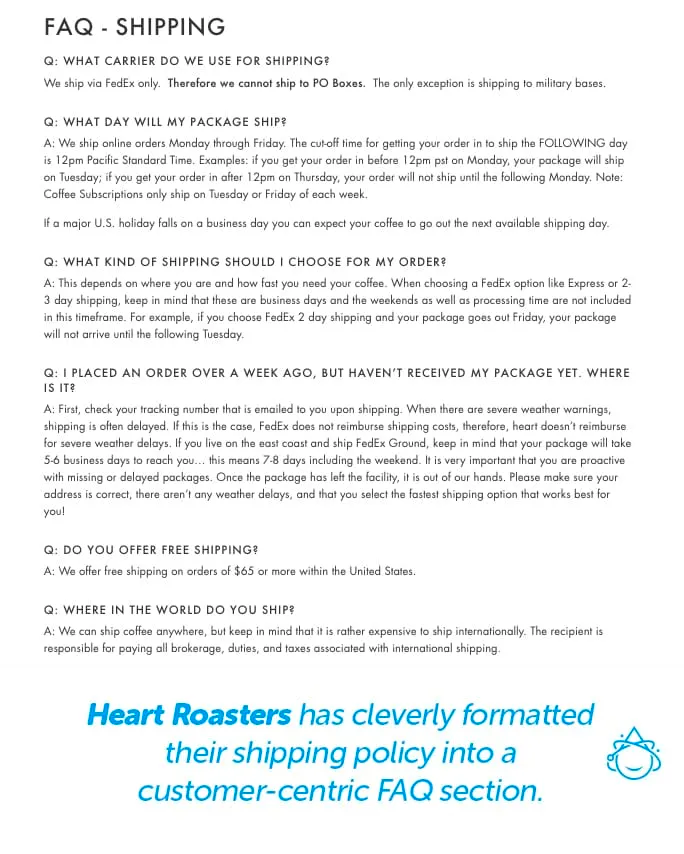
Don’t Assume a Shipping Policy for Small Business Isn’t Important
Hands down, the biggest mistake ecommerce companies make when creating a shipping and return policy is not treating it as important.
Instead, they craft a policy or download a shipping policy template simply to have one without putting their own spin on it or considering the customer journey. These basic policies won’t delight customers or build trust with your brand, and they’re likely to lead to higher cart abandonment rates.
So if you haven’t already, make sprucing up your shipping and return policy a priority for this quarter. Hopefully, you’ve found plenty of inspiration in this article to make the job a bit easier.
Consider Hosting Your Online Store With Nexcess
A great hosting plan can be instrumental to growing your ecommerce business. Fortunately, Nexcess has you covered.
Our fully managed WooCommerce hosting plans are ideal for growing businesses. Specially designed to convert more sales, the plan is packed with cutting-edge technologies to reduce query load times and cart abandonment rates.
To learn more about fully managed WooCommerce hosting, check out our plans today.

